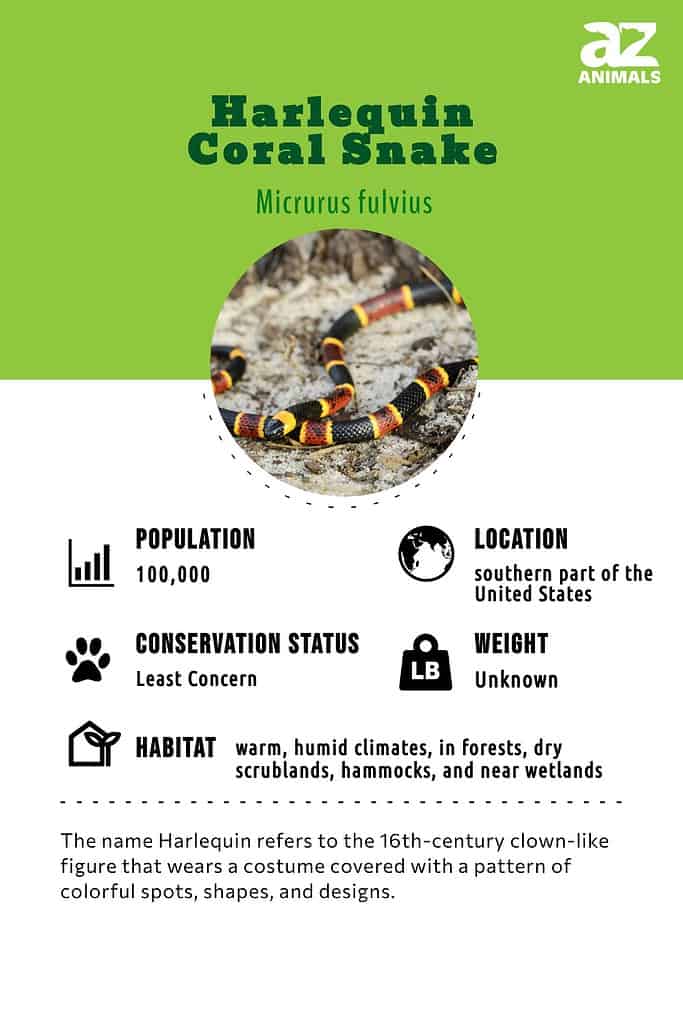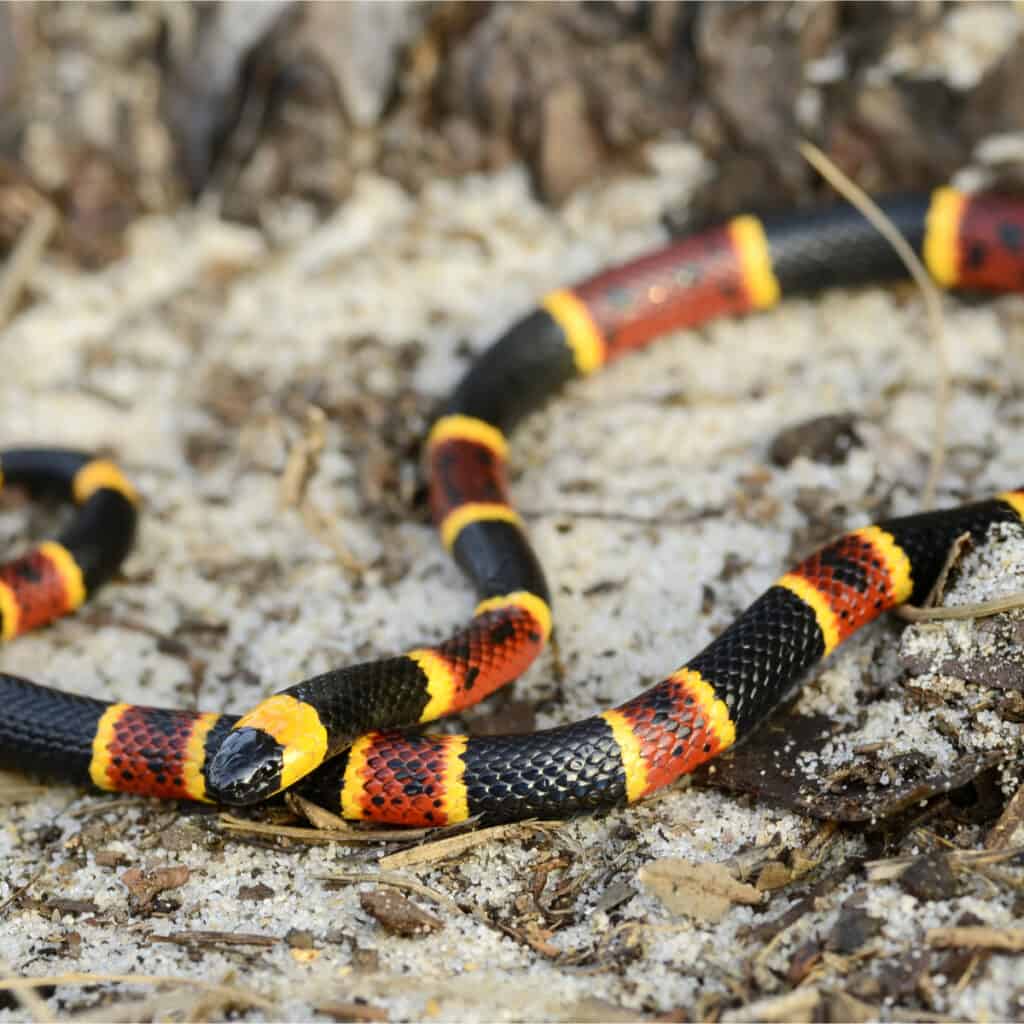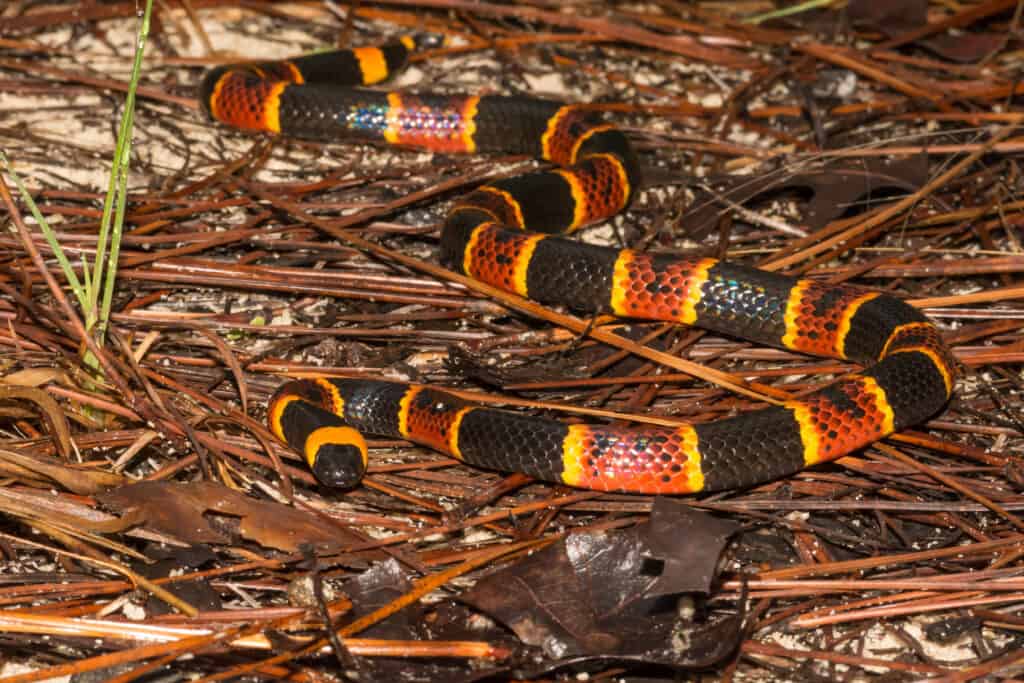Harlequin Coral Snake
Micrurus fulvius
They are sometimes called American cobras because they belong to the same family as cobras!
Advertisement
https://a-z-animals.com/wp-admin/post.php?post=161982&action=edit#Harlequin Coral Snake Scientific Classification
- Kingdom
- Animalia
- Phylum
- Chordata
- Class
- Reptilia
- Order
- Squamata
- Family
- Elapidae
- Genus
- Micrurus
- Scientific Name
- Micrurus fulvius
Read our Complete Guide to Classification of Animals.
Harlequin Coral Snake Conservation Status
Harlequin Coral Snake Facts
- Prey
- Lizards, smaller snakes, frogs, and insects
- Fun Fact
- They are sometimes called American cobras because they belong to the same family as cobras!
- Estimated Population Size
- 100,000
- Most Distinctive Feature
- Black, red, and yellow bands of color
- Distinctive Feature
- Their bands of color cover both their backs and their bellies.
- Habitat
- Forests, dry scrublands, hammocks, and near wetlands.
- Diet
- Carnivore
- Lifestyle
- Diurnal
- Common Name
- Coral Snake
- Slogan
- Red touches yellow kills a fellow, red touches black a friend of Jack.
- Nesting Location
- Underground
View all of the Harlequin Coral Snake images!
A female harlequin coral snake can lay four to 13 eggs underground.
The Harlequin snake, or Eastern coral snake, is most notable for the black, yellow, and red rings running the length of its body. It lives in the southern United States and Mexico. They are carnivores killing their prey of lizards, insects, frogs, and fish with powerful venom. Their conservation status is the Least Concern.
4 Amazing Facts

- Hiding beneath forest vegetation most of the time keeps this snake safe from a passing owl, red-tailed hawk, and other predators.
- They are sometimes called American cobras because they belong to the same family as cobras. (But harlequin coral snakes don’t have an expanding hood.)
- A predator of this snake is easily confused by its colorful pattern and sometimes can’t tell its head from its tail.
- The female Harlequin snake is longer than the male.
Where to Find Harlequin Snakes
Harlequin coral snakes, or Eastern coral snakes, live in the southern part of the United States. Specifically, they occupy Florida, North Carolina, Georgia, Louisiana, and Texas. Their range also extends down into Mexico. They live in a warm, humid climate. These snakes live in forests, dry scrublands, hammocks, and near wetlands. They are known as reclusive snakes commonly found hiding beneath leaves and vegetation. Hiding keeps them safely out of sight of any predator in the area.
Harlequin coral snakes are especially active in late spring and fall. They go into brumation in the winter months to escape the cold and conserve energy. When it’s time to go into brumation, they burrow into the ground for both warmth and protection.
Types of Harlequin or Coral Snake

Harlequin Snakes are extremely venomous, but they avoid confrontation
©Patrick K. Campbell/Shutterstock.com
There are more than 65 known types of New World coral snakes. They belong to the Elapidae family.
- Texas coral snake (Micrurus tener)-It’s found in Mexico, Louisiana, and, of course, Texas. At 48 inches long, adult Texas coral snakes are larger than Eastern coral snakes.
- Uruguayan coral snake (Micrurus altirosis)-This South American venomous snake has a thicker body than the Eastern coral snake. But it shares a similar pattern of red, black, and white rings on its body.
- Annellated coral snake (Micrurus annellatus)-This coral snake lives in South America and can grow as long as 28 inches. The pattern of rings on its body can be dark blue, black, white, or yellow and red. It lives in a wet forest habitat.
- Guyana blackback coral snake (Micrurus collaris)-It is named after Latin collaris, which means iron collar or chain for the neck. This name alludes to its conspicuous light collar, which is the only complete band on its body. It is native to South America.
- Sonoran or Arizona coral snake (Micruroides euryxanthus)-This snake is native to the Sonora Desert region of northwestern Mexico and the southwestern United States, particularly Arizona. It tends to spend most of its hiding under rocks and logs but may emerge at sundown or during rainy or overcast weather.
Harlequin Coral Snakes in a Different Family
There are two other types of Harlequin snakes worth noting. These snakes are colorful, venomous, and native to Africa. They are members of the Lamprophiidae family.
- Striped Harlequin snake (Homoroselaps dorsalis)- The striped Harlequin snake is shorter than the Eastern coral snake at eight to 12 inches long. It is black with a bright yellow stripe running all the way down its back. It lives in the grasslands of South Africa.
- Spotted Harlequin snake (Homoroselaps lacteus)-This snake grows to a length of 12 to 16 inches. It has a black and white spotted body along with a splash of brilliant orange or yellow. Like the striped Harlequin, it lives in South Africa.
Scientific Name
Micrurus fulvius is the scientific name of the Harlequin snake also called the Eastern coral snake. The name Harlequin refers to the 16th-century clown-like figure that wears a costume covered with a pattern of colorful spots, shapes, and designs.
It belongs to the Elapidae family and the Reptilia class.

Harlequin Snakes (Coral Snakes) confuse their prey because it’s difficult to tell their heads from their tails
©Jay Ondreicka/Shutterstock.com
Population and Conservation Status
The specific population of the Eastern coral snake is unknown, but biologists estimate it at more than 100,000. The IUCN Red List of Threatened Species records it as the Least Concern with a stable population.
Evolution and History
Little is known about the ecology and natural history of the Harlequin coral snake.
One interesting aspect is this snake is known to have a lot of similar snakes look like it, but they aren’t venomous. This is called mimicry. The striking red–black banded color pattern in some snakes that are harmless is thought to evolved from highly venomous coral snakes throughout North and South America.
How to Identify: Appearance and Description
The Harlequin, or Eastern coral snake, has a pattern of black, yellow, and red bands. The bands cover both the back and the belly of this reptile. This is different from many other types of snakes with a pattern on their back paired with a solid underbelly.
This snake’s body is narrow and grows 20 to 30 inches in length. When comparing a male and a female Eastern coral snake, the female is longer.
Though the Eastern coral snake is not aggressive, it has very potent venom. Furthermore, it is similar in appearance to other snakes in its habitat.
Two of those non-venomous lookalikes are the scarlet kingsnake and the scarlet snake. The scarlet kingsnake and the scarlet snake display red, black, and yellow bands. The difference has to do with the pattern of color. On an Eastern coral snake, the yellow and red bands touch. Alternatively, on the scarlet kingsnake and the scarlet snake, the black and yellow bands touch. This subtle difference lets you know that the scarlet kingsnake and the scarlet snake are non-venomous. There’s even a little poem you can memorize: ‘Red touches yellow kills a fellow, red touches black a friend of Jack.’ However, experts say that it only confirms a coral snake that fits the typical pattern in the U.S.
There are a couple of other differences between these two non-venomous snakes and the venomous Eastern coral snake. The scarlet kingsnake has a red nose while the Eastern coral snake has a black nose. In addition, the scarlet snake has a white belly while the Eastern coral snake’s bands of color run completely around its entire body.
How to identify an Eastern Coral Snake:
- Red, yellow, and black bands
- A repeating pattern of bands with red beside yellow and yellow beside black
- Colorful bands completely cover both its back and belly
- It has a black head

Unlike most snakes, a Harlequin Snake’s bands of color go completely around their bodies.
©Mark_Kostich/Shutterstock.com
Venom: How Dangerous Are They?
The Harlequin coral snake is venomous. However, it’s known as a shy, mild-tempered snake. Bites are rare and usually happen when someone accidentally reaches into or steps on a pile of leaf debris or vegetation where a Harlequin snake is hiding. These snakes are not looking for a confrontation.
If you’re bitten by a Harlequin coral snake, the first thing to do is move away from it to prevent further injury. Also, try to stay as still and calm as possible. Keep the area of the bite below the level of your heart if possible. For example, if you’re bitten on the wrist, keep your wrist down at your side. Clean the wound with mild soap and water, then dry it thoroughly. Gently cover the wound with a clean bandage.
After taking these steps, seek treatment from a medical professional. Don’t try to put on a tourniquet or extract the venom.
There is an antivenom available for Eastern coral snake bites. A medical professional’s help is necessary to determine the severity of the bite and take action to prevent infection.
Behavior and Humans
The Eastern coral snake is known as a timid, nervous snake. This is true with both male and female Eastern coral snakes. They try to avoid interaction with humans at all costs!
They are narrow-bodied snakes living beneath forest debris and in burrows underground. Though they are known for having potent venom, humans are very rarely bitten by these reclusive reptiles.
Similar Animals
View all 104 animals that start with HHarlequin Coral Snake FAQs (Frequently Asked Questions)
Are Harlequin snakes poisonous?
Yes, Harlequin snakes are poisonous. But they rarely use their venom on humans. Mostly, they use it to kill their prey.
How do Harlequin snakes hunt?
During the day, this snake travels quietly through the underbrush and vegetation in search of its prey: lizards, insects, and frogs. When it finds prey, this snake injects it with venom. Once it stops moving, the snake swallows its prey.
Are Harlequin snakes aggressive?
No, these snakes are known to be shy and nervous. If one sees a human, it’s most likely to rush for cover beneath forest debris.
Where do Harlequin snakes live?
They live in the southern part of the United States including Texas, Florida, North Carolina, Georgia, and Louisiana. These snakes are also found in Mexico.
Two other types of Harlequin snakes including the spotted and the striped Harlequin snake live in South Africa.
What do Harlequin snakes eat?
They are carnivores eating insects, lizards, frogs, and sometimes smaller snakes.
How long are Harlequin snakes?
They can be 20 to 30 inches long.
Thank you for reading! Have some feedback for us? Contact the AZ Animals editorial team.
Sources
- Florida Museum, Available here: https://www.floridamuseum.ufl.edu/florida-snake-id/snake/harlequin-coralsnake/
- Wikipedia, Available here: ttps://en.wikipedia.org/wiki/Coral_snake
- IUCN Red List, Available here: https://www.iucnredlist.org/species/64033/12738512
- African Snake Bite Institute, Available here: https://www.africansnakebiteinstitute.com/snake/spotted-harlequin-snake/
- NC Wildlife, Available here: https://www.ncwildlife.org/Learning/Species/Reptiles/Eastern-Coral-Snake
- Florida Museum, Available here: https://www.floridamuseum.ufl.edu/florida-snake-id/snake/scarlet-kingsnake/
- Wild Mag, Available here: http://wildmag.org/facts/Coralsnake.asp?page=/facts/Coralsnake.asp
- African Snakebite Institute, Available here: https://www.africansnakebiteinstitute.com/snake/spotted-harlequin-snake/

















